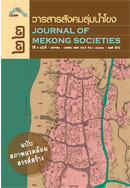Spatial Formation and Transformation of Tai-Lao Villages and Dwellings in Paksy Village, Luang Prabang, Laos
Main Article Content
Abstract
The purpose of this study is to consider the formation of traditional Tai-Lao settlements located in the North of the Central Mekong Basin, Luang Prabang, Laos. The village in this study is set on a mound that lies between the Mekong River and the mountain. The area has features that are different from those in other Tai-Lao settlements presented in previous studies which are mainly on flat land. For the study of the settlement formation, a spatial analysis was carried out, centered on architectural orientation, arrangement concepts, beliefs, site positions, directions, and spatial arrangements. The data were obtained through fieldwork in the communities. The study reveals that the Tai-Lao settlement of Paksy village is formed by the Upper-Lower concept and by religious and local beliefs. This settlement consists of Buddhist elements, such as the temple, and the spirit items, such as the village pillar and the spirit house. These beliefs have significant impacts on spatial arrangements in the community, spatial meanings, and the social norms and lives of the Tai-Lao people.

